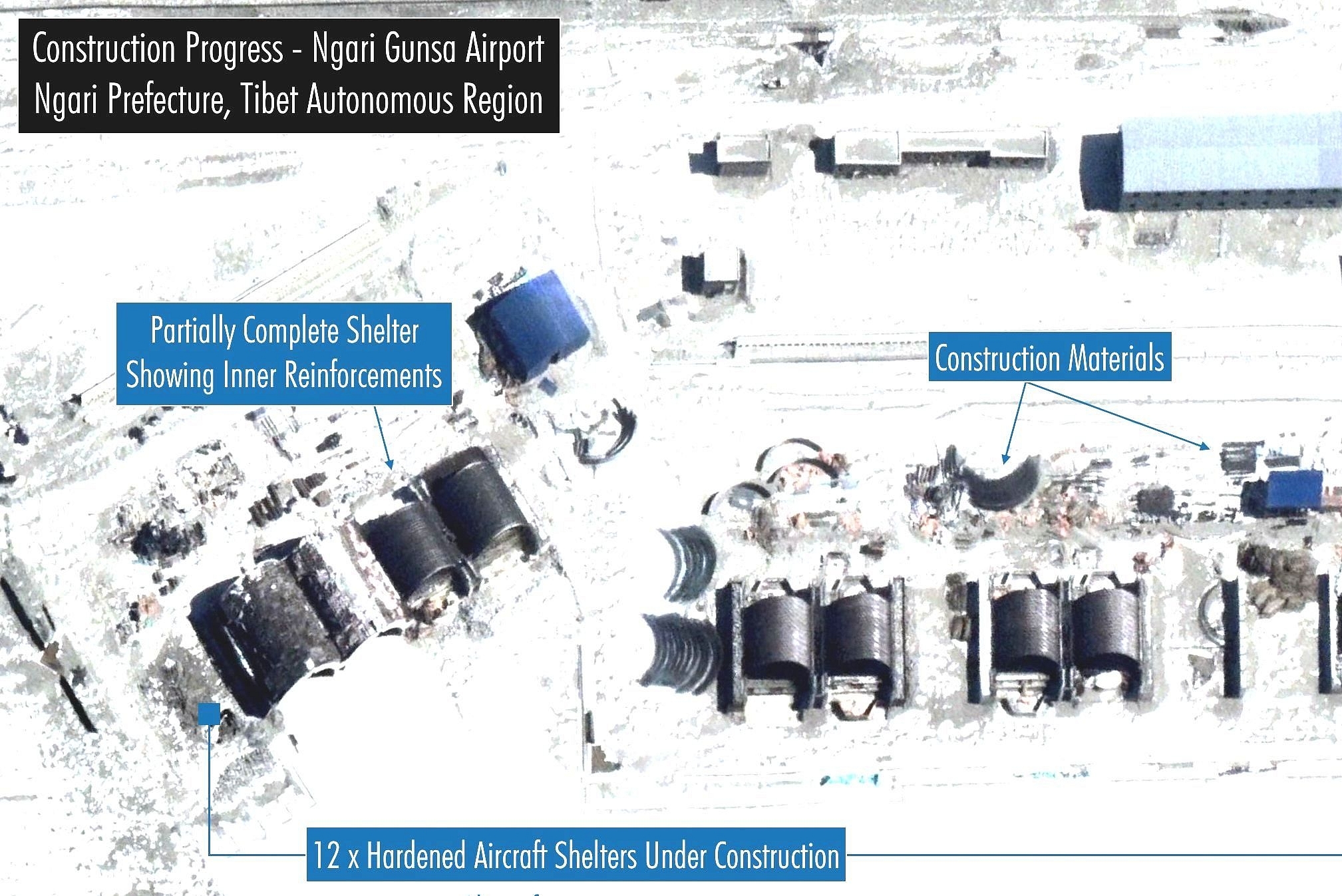News Brief
Satellite Images Show China Is Expanding Its Airbase Near Ladakh, Building Hardened Shelters For Fighter Jets
- Hardened shelters are reinforced hangars used for shielding fighter jets from enemy missiles and bombs.
- At least 12 hardened shelters are under construction at the airbase.

PLAAF’s Ngari Gunsa airbase, located close to Ladakh. (@detresfa_/Twitter)
Satellite imagery from February 2021 shows that China is expanding its Ngari Gunsa airbase close to Ladakh, located only 200 kilometres away from the Pangong Lake.
The Ngari Gunsa base, which also serves as a civilian airport, is located in Tibet’s Ngari prefecture at an elevation of around 14,000 feet. The base, located very close to the Line of Actual Control (LAC), was operationalised in 2010.
The latest satellite image, posted by open source intelligence handle @detrasfa_ on Twitter, show that the People’s Liberation Army Air Force (PLAAF) is building hardened aircraft shelters at the base.
Hardened shelters, also known as blast pens, are reinforced hangars used for shielding fighter jets from enemy missiles and bombs.
At least 12 hardened shelters are under construction at the airbase.
According to experts, the construction of hardened aircraft shelters at the base hints that China plans to increase the presence of its air assets, including drones, at Ngari Gunsa, over the next few years, to counter India’s deployments in Ladakh.
The expansion of the base, which began sometime in early 2020, continued throughout the military standoff in eastern Ladakh.
In May 2020, during the standoff, rapid construction activity was seen at the PLAAF base. As reported earlier, satellite images from April and May 2020 showed construction in a large area parallel to the runway.
Large-scale earth work, ongoing from April 2020, was seen in a satellite image dated 15 May, next to the 4,500 metre runway of the airbase.
Back then, reports said it could be a “second taxi-track or a secondary tarmac”.
Satellite imagery of the base from May 2020 also show at least four PLAAF fighter jets, possibly J-11s or J-16s (Chinese variants of the Russian Su-27).
The deployment of this detachment of fighter jets at the Ngari Gunsa airbase was first seen in December 2019, just months before China surprised India by deploying thousands of People’s Liberation Army soldiers, supported by heavy equipment, along the LAC in eastern Ladakh.
During the standoff, a Chinese military insider had told the South China Morning Post that the PLAAF had deployed its J-16s at Ngari Gunsa for “regular training” but decided to retain the aircraft at the base “because of the stand-off”.
China had also deployed additional fighter jets at its base in Hotan, north of Ladakh.
According to China Aerospace Studies Institute (CASI), based at the US Air and Space Force's Air University in Alabama, the PLAAF usually deploys around 12 unidentified variants of Flanker (Su-27) at its base in Hotan.
However, satellite images dated 14 June show China deployed “an additional 24 aircraft” at this airbase.
During the standoff, China expanded infrastructure at other air bases as well.
Recent satellite imagery shows that China has finished upgrading the main surface-to-air missile (SAM) site adjacent to the Lhasa Gonggar airport, which also serves as a major base for the PLAAF on the Tibetan Plateau. The airbase is located at a distance of around 200 km from Arunachal Pradesh and 300 km from Sikkim.
The expansion of the SAM site comes at a time when India is deploying Rafale fighters and Apache attack helicopters in the North East.
Support Swarajya's 50 Ground Reports Project & Sponsor A Story
Every general election Swarajya does a 50 ground reports project.
Aimed only at serious readers and those who appreciate the nuances of political undercurrents, the project provides a sense of India's electoral landscape. As you know, these reports are produced after considerable investment of travel, time and effort on the ground.
This time too we've kicked off the project in style and have covered over 30 constituencies already. If you're someone who appreciates such work and have enjoyed our coverage please consider sponsoring a ground report for just Rs 2999 to Rs 19,999 - it goes a long way in helping us produce more quality reportage.
You can also back this project by becoming a subscriber for as little as Rs 999 - so do click on this links and choose a plan that suits you and back us.
Click below to contribute.
Latest